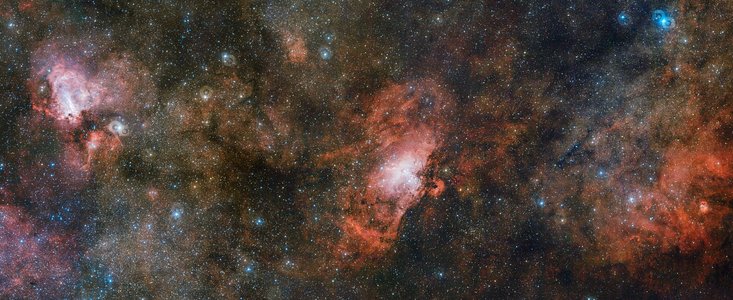Iconic Nebulas and Bright Gas Cloud Shine in Massive, Mesmerizing Photo
Two iconic star-forming regions called nebulas and a bright gas cloud shine brightly in a new mega-scale image. The picture, taken by the European Southern Observatory's (ESO) VLT Survey Telescope (VST) in Chile, is 3.3 gigapixels in size, making it one of the largest images ever created using data from the observatory.
The image shows, from left to right, the Omega Nebula, the Eagle Nebula and a gas cloud called Sharpless 2-54. All three objects are roughly 7,000 light-years away. The Omega Nebula is located in the constellation Serpens (The Serpent), while the other two are found in the constellation Sagittarius.
"This region of the Milky Way houses a huge cloud of star-making material," ESO officials said in a statement. "The three nebulae indicate where regions of this cloud have clumped together and collapsed to form new stars; the energetic light from these stellar newborns has caused ambient gas to emit light of its own, which takes on the pinkish hue characteristic of areas rich in hydrogen." [The Fabulous Lives of Nebulas]
The massive new image was created from a mosaic of dozens of pictures, each one 256 megapixels in size, from the telescope's OmegaCAM camera. The final image required lengthy processing before being released, ESO officials added.
Both Sharpless 2-54 and the Eagle Nebula were discovered after astronomers spotted bright star clusters in their midst in the 1700s, although it took them some time to spot the larger gas cloud encompassing the clusters. Professional astronomers typically identify objects by official names in catalogs, using designation numbers, whereas amateur astronomers tend to use nicknames for these objects.
Sharpless 2-54 was so dim that its gas cloud was not discovered until the 1950s, by American astronomer Stewart Sharpless. However, a star cluster embedded in the nebula called NGC 6604, visible on the object's left side in the image, was found by British astronomer William Herschel in 1784.
The Eagle Nebula was discovered in the 1760s by French astronomer Charles Messier, and it's noted as Messier 16 in his famous catalog. His discovery came only two decades after Swiss astronomer Philippe Loys de Chéseaux found a bright star cluster in the nebula's midst.
Breaking space news, the latest updates on rocket launches, skywatching events and more!
The Omega Nebula was cataloged by de Chéseaux in 1745. However, the Swiss astronomer's catalog was never widely used. This meant that when Messier rediscovered the object in 1764, it was his designation — Messier 17 — that was used to identify the Omega Nebula.
Follow us @Spacedotcom, Facebook and Google+. Original article on Space.com.

Elizabeth Howell (she/her), Ph.D., was a staff writer in the spaceflight channel between 2022 and 2024 specializing in Canadian space news. She was contributing writer for Space.com for 10 years from 2012 to 2024. Elizabeth's reporting includes multiple exclusives with the White House, leading world coverage about a lost-and-found space tomato on the International Space Station, witnessing five human spaceflight launches on two continents, flying parabolic, working inside a spacesuit, and participating in a simulated Mars mission. Her latest book, "Why Am I Taller?" (ECW Press, 2022) is co-written with astronaut Dave Williams.



